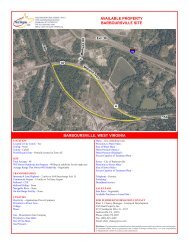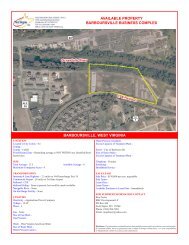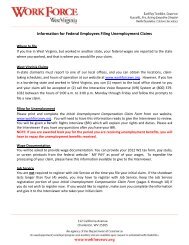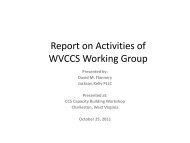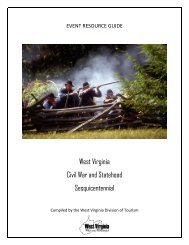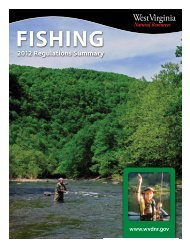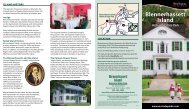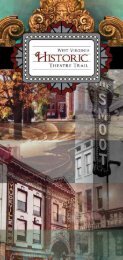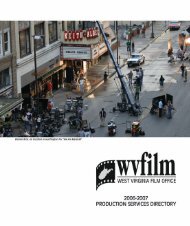C I V I L W A R H E R I T A G E - West Virginia Division of Tourism
C I V I L W A R H E R I T A G E - West Virginia Division of Tourism
C I V I L W A R H E R I T A G E - West Virginia Division of Tourism
- No tags were found...
Create successful ePaper yourself
Turn your PDF publications into a flip-book with our unique Google optimized e-Paper software.
The slavery question, which between 1830and 1860 tore at the fabric <strong>of</strong> the nation, left theCommonwealth <strong>of</strong> <strong>Virginia</strong> equally as divided.Perhaps the most incendiary <strong>of</strong> all events connected withthe slavery issue took place on what is now <strong>West</strong> <strong>Virginia</strong>soil, with the seizure <strong>of</strong> the federal arsenal at HarpersFerry in 1859 by the fiery abolitionist, John Brown. Hisplan for arming the slaves <strong>of</strong> northern <strong>Virginia</strong> andcoordinating an uprising, together with the secretivenesswith which his plan was carried out, threw the South intoa panic.In the wake <strong>of</strong> the firing upon Fort Sumter and PresidentLincoln's call for volunteers, sentiment in the <strong>Virginia</strong>Convention shifted drastically. Many delegates who hadopposed secession now just as vigorously opposed thePresident's intention to use the coercive powers <strong>of</strong> thefederal government against a state. Therefore, when thequestion <strong>of</strong> <strong>Virginia</strong>'s position came to a vote, themajority cast their ballots in favor <strong>of</strong> joining the newlyformed Confederate States <strong>of</strong> America. However, <strong>of</strong> the47 delegates from western <strong>Virginia</strong>, 32, or more thantwo-thirds, voted against leaving the Union.The future <strong>of</strong> the newly proposed state depended uponcontrol <strong>of</strong> western <strong>Virginia</strong> by Union military forces.From the outset <strong>of</strong> the war, both the Union andConfederate governments endeavored to hold western<strong>Virginia</strong> because <strong>of</strong> its valuable salt resources, itsproductive farms and the strategic section <strong>of</strong> theBaltimore and Ohio Railroad, which traversed theeastern and northern sections <strong>of</strong> the state. Moreover,both sides were well aware <strong>of</strong> the psychologicaladvantages in controlling western <strong>Virginia</strong>. For theUnion, its possession would represent a serious inroadinto the Old Dominion, the most prestigious state <strong>of</strong> theConfederacy. For the Confederacy, its retention as a part<strong>of</strong> <strong>Virginia</strong> would demonstrate strength and helppreserve the high morale prevalent in much <strong>of</strong> the Southat the beginning <strong>of</strong> the war.
Most <strong>of</strong> the decisive fighting in what is now <strong>West</strong> <strong>Virginia</strong>took place before the end <strong>of</strong> 1861. In the EasternPanhandle, positions sometimes changed hands withbewildering frequency. Throughout the war, militaryaction there revolved around efforts to gain or retaincontrol <strong>of</strong> valuable segments <strong>of</strong> the Baltimore and OhioRailroad. In the campaigns in the Shenandoah Valley,western <strong>Virginia</strong>'s distinguished Confederate General,Thomas Jonathan “Stonewall” Jackson, played a vital part.Farther south, the Confederates took the initiative andpushed Union troops out <strong>of</strong> Fayetteville and Charleston.With the engagements at White Sulphur Springs (orRocky Gap) and Droop Mountain in the autumn <strong>of</strong> 1863,the Confederates had been forced out <strong>of</strong> most <strong>of</strong><strong>West</strong> <strong>Virginia</strong>.During the early years <strong>of</strong> the Civil War, the statehoodissue continued to be debated. The Restored Government<strong>of</strong> <strong>Virginia</strong> eventually approved <strong>of</strong> the separation, whichleft Congress as the last hurdle. After considerable debate,the <strong>West</strong> <strong>Virginia</strong> statehood bill passed the U.S. Senate bya vote <strong>of</strong> 23 to 15, and the House <strong>of</strong> Representatives by avote <strong>of</strong> 96 to 55. Although he had misgivings about thestatehood question, President Lincoln issued aproclamation under which <strong>West</strong> <strong>Virginia</strong> entered theUnion on June 20, 1863, as the 35th state.The Civil War has <strong>of</strong>ten been referred to as a war <strong>of</strong>brother against brother and father against son. No otherstate serves as a better example <strong>of</strong> this than<strong>West</strong> <strong>Virginia</strong>, where there was relatively equal supportfor the northern and southern causes. Often families weresplit down the middle over their beliefs on the war. Thereare many instances <strong>of</strong> divided loyalties and individualsfighting for both sides.While many historians have traditionally placed thenumber <strong>of</strong> Union troops from <strong>West</strong> <strong>Virginia</strong> at a muchhigher figure than Confederates, more recent studiessuggest there were almost as many southern troops asnorthern. Traditional sources have placed the number <strong>of</strong>Union soldiers from <strong>West</strong> <strong>Virginia</strong> as high as 36,000,compared to only 7,000 to 10,000 Confederates. Many <strong>of</strong>the Union soldiers in <strong>West</strong> <strong>Virginia</strong> regiments were fromOhio and Pennsylvania. At least one recent study hasraised the southern number to more than 20,000 andlowered the Union figure to about the same.John Brown’s RaidJohn Brown believed he couldfree the slaves, and he selectedHarpers Ferry, Va., as hisstarting point. Determined toseize the 100,000 weapons atthe Arsenal and to use the BlueRidge Mountains for guerrillawarfare, abolitionist Brownlaunched his raid on Sundayevening, Oct. 16, 1859. His21-man “Provisional Army <strong>of</strong>the United States” seized theUnited States Armory, ArsenalJohn Brownand several other strategicpoints. Brown had come to arm an uprising <strong>of</strong> slaves.Instead, the raid drew militia companies and federal troopsfrom Maryland, <strong>Virginia</strong> and the District <strong>of</strong> Columbia. Onthe morning <strong>of</strong> Oct. 18, a storming party <strong>of</strong> 12 Marines,under the command <strong>of</strong> Lt. Col. Robert E. Lee <strong>of</strong> the SecondUnited States Cavalry (with his aide, Lt. J.E.B. Stuart, <strong>of</strong> theFirst United States Cavalry), broke down the door <strong>of</strong> theArmory's engine house and 36 hours after the raid began,with most <strong>of</strong> his men killed or wounded, Brown wascaptured.Brought to trial at nearby Charles Town, Va., Brown wasfound guilty <strong>of</strong> treason against the Commonwealth <strong>of</strong><strong>Virginia</strong>, <strong>of</strong> conspiring with slaves to rebel and murder.Fearing threats that an attempt might be made by Northernsympathizers to rescue Brown, <strong>Virginia</strong> Governor Henry A.Wise ordered <strong>Virginia</strong> troops to Charles Town to guard theprisoners until after their execution. Toward the last <strong>of</strong>
The First Campaign<strong>West</strong> <strong>Virginia</strong>, born <strong>of</strong> a nation divided, was the setting forthe first campaign <strong>of</strong> America's Civil War. Although still part<strong>of</strong> <strong>Virginia</strong> in 1861, many citizens <strong>of</strong> the west remained loyalto the Union, rather than the Confederacy.By late May, Union Gen. George B. McClellan, commandingthe Department <strong>of</strong> the Ohio, launched the First Campaign— ordering troops to cross the Ohio River and secure“western” <strong>Virginia</strong> for the Union.Federal Troops at Armory Engine HouseNovember about 1,000 were assembled, among them thecadets <strong>of</strong> <strong>Virginia</strong> Military Institute, under the command <strong>of</strong>Col. F. H. Smith, the superintendent. Major Thomas J.“Stonewall” Jackson was present in command <strong>of</strong> the cadetbattery.Before his sentence was carried out, Brown issued aprophetic warning:“I wish to say furthermore, that you had better — all youpeople at the South — prepare yourselves for a settlement <strong>of</strong>that question that must come up for settlement sooner thanyou are prepared for it. The sooner you are prepared thebetter. You may dispose <strong>of</strong> me very easily; I am nearlydisposed <strong>of</strong> now; but this question is still to be settled — thisNegro question I mean — the end <strong>of</strong> that is not yet.”He was hanged on Dec. 2, 1859. On the day <strong>of</strong> the execution,bells were tolled and minute guns fired in many places in theNorth. Church services and public meetings were held forthe purpose <strong>of</strong> glorifying his deeds and sanctifying the causehe represented, recognizing in him a martyr to the teachings<strong>of</strong> the abolitionists. Eventually, his name became the sloganunder which, as a battle hymn, the Northern troops invadedand overran the South.Here, during June-July 1861, McClellan's army won theinaugural Union victories <strong>of</strong> the Civil War. Hailed as theNorth's first battlefield hero, McClellan was summoned toWashington on July 22, following a stunning Union debacleat Manassas, <strong>Virginia</strong>. Federal troops now occupied western<strong>Virginia</strong>, as loyal delegates met in Wheeling to form the“Restored Government <strong>of</strong> <strong>Virginia</strong>” — a Union governmentto oppose the Confederate one in Richmond.By August 1861, Southern forces again threatened.Confederate Gen. Robert E. Lee attempted to reclaimwestern <strong>Virginia</strong>, but failed miserably, prompting his returnto Richmond in October with the unglamorous nickname“Granny” Lee. Troops <strong>of</strong>both armies remained toguard the mountainpasses during thatterrible winter. By 1862,conflict shifted east. Thefirst campaign proved toIndependence Hall, Wheelingbe decisive: The westerncounties under Unioncontrol became the newstate <strong>of</strong> <strong>West</strong> <strong>Virginia</strong> in 1863. The arduous conflict in thesemountains forged armies and leaders — notably McClellan,Lee, and Stonewall Jackson — who shaped the course <strong>of</strong> theCivil War.John Brown's short-lived raid failed,but his trial and execution focusedthe nation's attention on the moralissue <strong>of</strong> slavery and headed thecountry toward civil war.Philippi, <strong>West</strong> <strong>Virginia</strong>
Jones-Imboden Raids <strong>of</strong> 1863Confederate leaders chose to harass Union troops andconfiscate supplies. In the spring <strong>of</strong> 1863, Gen. John D.Imboden designed a raid to destroy portions <strong>of</strong> the B&ORailroad and break up the Restored Government <strong>of</strong> <strong>Virginia</strong>in session in Wheeling. With a force <strong>of</strong> 3,400 men, Imbodenmarched out from Staunton, Va., on April 20. Gen. WilliamE. Jones led a group <strong>of</strong> 1,300 from Lacey Springs, Va., thefollowing day.Imboden's men marchedthrough Beverly andcaptured the town <strong>of</strong>Buckhannon on April 29.Jones joined Imboden atBuckhannon after failing todestroy the B&O line atRowlesburg in PrestonBurning Springs, <strong>West</strong> <strong>Virginia</strong>County, capturingMorgantown and destroying the railroad bridge at Fairmont.On May 6, Jones' troops marched from <strong>West</strong>on through<strong>West</strong> Union and Cairo. Three days later, he destroyed150,000 barrels <strong>of</strong> oil and the oil works at Burning Springs inWirt County. On May 14, Jones joined Imboden atSummersville before retreating into <strong>Virginia</strong>. Although itsucceeded in destroying property and industry, driving awaylivestock, and occupying the attention <strong>of</strong> Union troops whichmight have been used elsewhere, the Jones-Imboden Raidfailed to destroy significant portions <strong>of</strong> the B&O or break upthe Restored Government <strong>of</strong> <strong>Virginia</strong>.Civil War Discovery TrailThe Civil War Discovery Trail links more than 500 sites in28 states to inspire and teach the story <strong>of</strong> the Civil War andits haunting impact on America. The Trail, an initiative <strong>of</strong> theCivil War Preservation Trust, allows visitors to explorebattlefields, historic homes, railroad stations, cemeteries,parks and other destinations that bring history to life.For more information on the Civil War Discovery Trail andother programs <strong>of</strong> The Civil War Trust, call1-800-CWTRUST.1. Belle Boyd HouseFamous Civil War Spy Belle Boydspent part <strong>of</strong> her childhood in thishouse built in 1853. During the war,she supplied information toStonewall Jackson about enemyactivities and was imprisoned twicebefore being banished to England.LOCATION: 126 East Race Street, downtown Martinsburg.ADDRESS: 126 East Race St., Martinsburg, WV 25401.TELEPHONE: (304) 267-47132. Bulltown Historic DistrictIn 1863, Confederate forcesled by William L. “Mudwall”Jackson, cousin <strong>of</strong> “Stonewall”Jackson, attempted toovertake Union fortificationson a knoll overlooking a keybridge that once crossed theRe-enactors at Stonewall Jackson Jubilee Little Kanawha River alongthe <strong>West</strong>on-Gauley BridgeTurnpike. At the hilly site are Union trenches, the graves <strong>of</strong>seven Confederate soldiers and intact sections <strong>of</strong> theTurnpike. The district also features the restored Cunninghamfarm that reflects the period living conditions <strong>of</strong> the area. TheBulltown Historic Center features costumed staff and artifactsfrom the battle.LOCATION: Off I-79 at Exit 67, 13 miles north on U.S. Rt. 19 or Exit 91 <strong>of</strong>fI-79, 2 miles south on U.S. Rt. 19.ADDRESS: HC 10, Box 24, Burnsville, WV 26335.TELEPHONE: (304) 853-2371 (<strong>of</strong>fice)
3. Burning Springs ParkThe Rathbone Well, one <strong>of</strong> the first and oldest producingpetroleum wells in the country, was drilled in 1860. In May1863, General William E. “Grumble” Jones commandedConfederate forces to raid and set fire to oil tanks, barrelsand boats in an attempt to block the Union's use <strong>of</strong> thisresource. The self-guided tour <strong>of</strong>fers interpretive signage,buildings, and artifacts <strong>of</strong> the early oil industry.LOCATION: I-77 Exit 170. Follow Rt.14 South for13 miles to Elizabeth.Turn left on Rt. 5 for 7 miles.ADDRESS: P.O. Box 1685, 119 Third Street, Parkersburg, <strong>West</strong> <strong>Virginia</strong>,26101TELEPHONE: (304) 485-5446WEBSITE: www.oilandgasmuseum.com4. Camp AlleghenyAt 4,400 feet above sea level, this camp, established byConfederate forces in the summer <strong>of</strong> 1861 to control theStaunton-Parkersburg Turnpike, was one <strong>of</strong> the highest <strong>of</strong>the Civil War. Soon after the October Battle <strong>of</strong> GreenbrierRiver, troops withdrawing from Camp Bartow, at the foot <strong>of</strong>the mountain, joined the soldiers at Camp Allegheny. Thishaunting, windswept encampment was successfullydefended during a seven and a half-hour battle on Dec. 13,1861, when Confederate General Edward Johnson’s troopsrepelled an attack by Union forces from Cheat Summit Fortunder the command <strong>of</strong> General R. H. Milroy. However, theloss <strong>of</strong> men because <strong>of</strong> the harsh winter conditions andlogistical nightmare <strong>of</strong> keeping the camp suppliedcontributed to the decision to abandon it in April 1862.Earthworks, gun positions and chimney falls from theencampment are evident.LOCATION: From U.S. 250 near the VA/WV state line, turn south at sign onCounty Rd. 3, turn right at the T junction, then go two more milesADDRESS: P.O. Box 67 Bartow, WV 26241TELEPHONE: (304) 456-3335Battle Ground <strong>of</strong> Greenbrier River
<strong>West</strong> <strong>Virginia</strong> State Archives, Boyd B. Stutler CollectionMajor-General George B. McClellanCivil War CemeteriesBERKELEY COUNTYGreen Hill Cemetery, 485 East Burke St., Martinsburg.Covering all sides <strong>of</strong> a cone-shaped hill, the 1854 cemetery is laidout in circles taken from a French design. Among the graves are30 unknown Confederate soldiers, as well as Capt. E.G. Alburtis,who commanded the Berkeley Company at Harpers Ferryduring the John Brown raid.GREENBRIER COUNTYGreenbrier Resort, White Sulphur Springs, (near HilltopTennis Courts). A simple marker indicates the burial <strong>of</strong> 16unknown Confederate soldiers who died <strong>of</strong> wounds received atthe Battle <strong>of</strong> Dry Creek, August 26-27, 1863.Blue Sulphur Springs, C.R. 25, three miles south <strong>of</strong> Smoot <strong>of</strong>fI-64. A state historical marker and simple headstone identifythe final resting place <strong>of</strong> 89 unknown Georgian soldiers whodied while encamped near here during the winter <strong>of</strong> 1862-1863.Confederate Cemetery, Lewisburg. The cemetery features amass grave <strong>of</strong> 95 unknown Confederate soldiers who diedduring the Battle <strong>of</strong> Lewisburg on May 23, 1862. The graveswere laid out in a cross design on a hilltop on the edge <strong>of</strong> town.There also are graves <strong>of</strong> three known Confederate States <strong>of</strong>America veterans interred after the war.Old Stone Presbyterian Church, 200 Church St.,Lewisburg. Following the Battle <strong>of</strong> Lewisburg, May 23,1862, the Old Stone Presbyterian Church was used as ahospital. Several Civil War veterans are buriedin the church cemetery.HARDY COUNTYOlivet Cemetery, Moorefield. Formally setaside as a cemetery in 1851, the shelling <strong>of</strong>Moorefield took place from this hillside in 1863.A section <strong>of</strong> the cemetery is noted on a mapas “Confederate dead,” and features a largemonument, which was erected by theMemorial Association in 1873. The obeliskhas plaques on each <strong>of</strong> the four sidesrecognizing the McNeill Rangers, Hardy Bluesand Grays and the 18th and 7th <strong>Virginia</strong> Cavalries.The monument stands in the center <strong>of</strong> a double ring<strong>of</strong> gravestones.
HARRISON COUNTYJackson Cemetery, Clarksburg, East Pike St., between CherrySt. and Charleston Ave. This family plot is the final restingplace <strong>of</strong> General Thomas “Stonewall” Jackson's greatgrandparents,father and sister.JEFFERSON COUNTYElmwood Cemetery, Shepherdstown. The ElmwoodCemetery includes the graves <strong>of</strong> several Confederate veteransincluding Henry Kyd Douglas, staff <strong>of</strong>ficer to General“Stonewall” Jackson, and General William W. Kirkland(Confederate States <strong>of</strong> America).Zion Episcopal Church and Cemetery, East CongressSt., Charles Town. Several prominent local Confederates areburied here including General Robert E. Lee's cartographer, S.Howell BrownKANAWHA COUNTYSpring Hill Cemetery, Charleston. Offering commandingviews <strong>of</strong> the city, this cemetery includes a section with severalConfederate soldiers' graves.<strong>Virginia</strong>’s Chapel and Slave Cemetery, U.S. Rt. 60,Cedar Grove. This quaint chapel served as a Confederatehospital and Union stable during the war. A slave cemetery islocated behind the church.RANDOLPH COUNTYMount Iser Cemetery, near Beverly (Butcher Hill HistoricDistrict). At least 62 Confederate soldiers and one civilian,many <strong>of</strong> them killed at the Battle <strong>of</strong> Rich Mountain, are buriedin this small cemetery surrounded by Union fortifications.Grafton National CemeteryTAYLOR COUNTYGrafton National Cemetery,431 Walnut St.(See featured listing).General Robert E. LeeCamp Allegheny, but were driven back. The site is alsosignificant for, perhaps, the earliest use <strong>of</strong> telegraphtechnology in the Civil War. The unique earthworks <strong>of</strong> thisencampment remain.LOCATION: From U.S. 250, near Cheat Bridge, turn south at sign,turn right at T junction, then go one mile to top <strong>of</strong> ridge.ADDRESS: Monongahela National Forest, 200 Sycamore St.,Elkins, WV 26241TELEPHONE: (304) 636-18007. Craik-PattonHouseJames Craik,grandson <strong>of</strong>Dr. James Craik,who was friendand physician toCraik-Patton House, Charleston, <strong>West</strong> <strong>Virginia</strong>President GeorgeWashington, builtthis house in 1834. In 1859, it was sold to Susan Patton, wife<strong>of</strong> George Smith Patton, great-grandfather to the famousGeneral George Patton <strong>of</strong> WWII fame. After graduating from<strong>Virginia</strong> Military Institute, G.S. Patton came to the KanawhaValley to practice law and formed the Kanawha Riflemen andtook them into the Civil War on the side <strong>of</strong> the Confederacy.Colonel Patton was mortally wounded in the Battle <strong>of</strong>Winchester.LOCATION: Adjacent to Daniel Boone Park on Rt. 60 Kanawha Blvd., 1.5miles east <strong>of</strong> the state capital.ADDRESS: 2809 Kanawha Blvd., E., Charleston, WV 25311.TELEPHONE: (304) 925-53418. Droop Mountain BattlefieldState ParkA peaceful park witha panoramic viewnow marks the spotwhere one <strong>of</strong> <strong>West</strong><strong>Virginia</strong>’s largestand last importantbattles was foughton Nov. 6, 1863. TheLookout Tower at Droop Mountain5. Carnifex FerryBattlefield State ParkOn Sept. 10, 1861, Union troops led byBrigadier General William S. Rosecransengaged the Confederates and forcedthem to evacuate an entrenched positionon the Henry Patterson farm, whichoverlooked Carnifex Ferry. TheConfederate commander, Brigadier Gen.John B. Floyd, retreated to the south side <strong>of</strong> the GauleyRiver and eastward to Meadow Bluff near Lewisburg. ThisGen. Floyd’s Camp GauleyCommand Headquarters onTomkin’s FarmBrig. Gen. WilliamS. Rosecransbattle represented the failure <strong>of</strong>a Confederate drive to gaincontrol <strong>of</strong> the Kanawha Valley.As a result, the movement for<strong>West</strong> <strong>Virginia</strong> statehoodproceeded without seriousthreat from the South. Relics <strong>of</strong>the battle are housed in therestored Patterson House,which marked the division <strong>of</strong>Union and Confederate lines.LOCATION: From U.S. 19, south <strong>of</strong> Summersville, west on WV Rt. 129,to Carnifex Ferry Rd.ADDRESS: 1194 Carnifex Ferry Rd, Summersville, WV 26651TELEPHONE: (304) 872-0825Re-enactors at Carnifex FerryState Park6. Cheat Summit FortRestored Patterson HouseGen. George B. McClellan ordered this fort to be builtin 1861 to secure the Staunton-Parkersburg Turnpikeand protect the Baltimore and Ohio Railroad. TheConfederacy’s inability to take the fort in September, 1861, wascentral in the failure <strong>of</strong> Robert E. Lee’s western <strong>Virginia</strong>Campaign. In the October battle <strong>of</strong> Greenbrier River, troopsfrom Cheat Summit Fort, under Gen. R. H. Milroy, attackedCamp Bartow. Neither side could claim victory, and theUnion troops returned to Cheat Summit Fort, while theConfederates withdrew to Camp Allegheny. In December <strong>of</strong>the same year, soldiers from Cheat Summit Fort attacked
decisive victory <strong>of</strong> Union forces under Gen. William W.Averell over the Confederate army under Gen. John Echolsended serious efforts by the Confederacy to control<strong>West</strong> <strong>Virginia</strong>.LOCATION: Off U.S. 219, 5 miles south <strong>of</strong> Hillsboro.ADDRESS: HC 64, Box 189, Hillsboro, WV 24946.TELEPHONE: (304) 653-4254WEBSITE: www.droopmountainbattlefield.com9. FayettevilleHistoric DistrictThe Indirect Artillery Firingmethod, later used around theFayetteville Historic Districtworld, was first used byConfederate Sgt. Milton W. Humphreys on May 19–20, 1863.During the Civil War, both Union and the Confederates camealong the old Giles, Fayette and Kanawha Turnpike toattack Fayetteville. A cemetery for the Confederate dead islocated at the Fleshman’s Farm.LOCATION: Route 19.ADDRESS: Kirk Wallace, P.O. Box 61, Fayetteville, WV 25840TELEPHONE: (304) 574-089010. Fort Boreman Civil War ParkLess than two miles from downtown Parkersburg, FortBoreman (named after <strong>West</strong> <strong>Virginia</strong>'s first governor)features a reconstructed Civil War fortification, trenches,interpretive signage, picnic shelters and nature trail. Thefort provides commanding views <strong>of</strong> Parkersburg, the OhioRiver and the Little Kanawha River. Although there was not abattle in Parkersburg, the fort was vital to the protection <strong>of</strong>thousands <strong>of</strong> Union soldiers from potential Confederate raidson Parkersburg and the railroad.LOCATION: 2 miles south <strong>of</strong> downtown Parkersburg on Corridor D/ WV-68ADDRESS: #1 Court Square, Suite 205, Parkersburg, WV 26101TELEPHONE: (304) 424-1976WEBSITE: www.greaterparkersburg.com/Attractions11. Fort Mill RidgeThis well-preserved earthen fortification was built betweenMarch and June 1863. Builders <strong>of</strong> the fort included the 54thPennsylvania Infantry and the 1st <strong>West</strong> <strong>Virginia</strong> Infantry. Thesite had previously been used by Confederate artillery todefend approaches to Romney. When Col. Jacob M.Campbell (54th PVI) garrisoned Union forces at Romney,
camps were set up at Mechanicsburg Gap. This site wasmore easily defended by the fort commanding theNorthwestern Turnpike, which became U.S. Rt. 50.LOCATION: Two miles west <strong>of</strong> Romney, on U.S. 50. Turn left onto roadleading to Fancy Hardwoods, follow signs.ADDRESS: 91 S. High St., Romney, WV 26757.TELEPHONE: (304) 822-432012. Fort MulliganThe valley <strong>of</strong> the South Branch<strong>of</strong> the PotomacRiver was a middle ground,situated between theCannon at Fort Mulliganall-important middleShenandoah Valley and the Upper Potomac region with itsvital coal resources and the B&O Railroad infrastructurecentered around Cumberland, Maryland.Federal or Confederate troops occupied this hill and itssurrounding area beginning at least as early as August 1861,and were on the ground for at least part <strong>of</strong> every year <strong>of</strong> thewar. Federal forces time and again tried to use this strategicpoint as a choke hold against raids on the B&O to the north,and as a jumping-<strong>of</strong>f point for their own raids further south.The Fort as it exists today was constructed August–December 1863, by troops under the command <strong>of</strong> ColonelJames A. Mulligan from Chicago, IL. Infantry, cavalry andartillery from <strong>West</strong> <strong>Virginia</strong>, Pennsylvania, Maryland andIllinois carried out the backbreaking labor.LOCATION: Off Rt. 28, turn onto Hospital Drive and make first rightCONTACT: SBVCWS, 964 Frosty Hollow Rd., Fisher, WV 26818.TELEPHONE: (304) 257-131313. General McClellan’s Headquarters(Anna Jarvis Birthplace Museum)14. Grafton NationalCemeteryThis cemetery was established in 1867by congressional legislation to <strong>of</strong>fer afinal resting place for the men whodied during the Civil War. Theremains <strong>of</strong> Union soldiers wereT. Bailey Brownremoved from temporary graves in<strong>West</strong> <strong>Virginia</strong> as well as several Union dead from Kentucky.Of the 1,215 graves, 664 are unknown and some areConfederate soldiers. Notably the grave <strong>of</strong> Private T. BaileyBrown, the first Union soldier to be killed by a Confederate,is located here.LOCATION: 431 Walnut St., Grafton.ADDRESS: Rt. 2, Box 127, Grafton, WV 26354.TELEPHONE: (304) 265-204415. Harpers Ferry NationalHistorical ParkThe first federal arsenal at Harpers Ferry was the site <strong>of</strong>abolitionist John Brown’s 1859 raid. The turmoil caused bythis attack sent ripples throughout the nation. Harpers Ferrychanged hands eight times during the war. StonewallJackson achieved his most brilliant victory here inSeptember 1862, when he captured 12,500 Union soldiers—the largest such surrender until WWII. Ultimately, it becamethe base <strong>of</strong> operations for Union Gen. Philip Sheridan’sinvasions into the Shenandoah Valley in 1864. Offeringcommanding views <strong>of</strong> the scenic confluence <strong>of</strong> the Potomacand Shenandoah Rivers, Harpers Ferry has been restored toBirthplace <strong>of</strong> the founder<strong>of</strong> Mother’s Day, this housewas used was used as a fieldheadquarters by Unioncommanders in the summer<strong>of</strong> 1861. Situated on theWheeling-Staunton Pike,Anna Jarvis Housewhich provided access tothe strategic Northwestern <strong>Virginia</strong> Railroad here, this wasa strategic supply depot throughout the war.LOCATION: U.S. 119/250, 4 miles south <strong>of</strong> Grafton.ADDRESS: Rt. 2, Box 352, Grafton, WV 26354.TELEPHONE: (304) 265-5549WEBSITE : www.annajarvishouse.comBurning <strong>of</strong> the U.S. Arsenal at Harpers Ferry
the era, and brick sidewalks lead toquaint shops and restaurants.LOCATION: Harpers Ferry, <strong>of</strong>f U.S.340.ADDRESS: P.O. Box 65, Harpers Ferry,WV 25425.TELEPHONE: (304) 535-6748WEBSITE : www.nps.gov/hafeArmory Engine House(John Brown’s Fort)17. Jefferson County CourthouseBuilt on land donated byGeorge Washington’s youngestbrother Charles, this 1836Greek Revival brick buildingwas the site for the famous trial<strong>of</strong> John Brown in 1859. Duringthe Civil War it served as abarracks for Union troops.LOCATION: Corner <strong>of</strong> George andWashington Sts., Charles TownADDRESS: P.O. Box 250, CharlesTown, WV 25414-0815.TELEPHONE: (304) 728-324018. Jefferson County MuseumJefferson County CourthouseCivil War image <strong>of</strong> Harpers Ferry16. WVU Jackson’s Mill Historic AreaThe site <strong>of</strong> Gen. Thomas J.“Stonewall” Jackson’s boyhoodhome. This historic area hasevolved into a community <strong>of</strong> 18thand 19th century buildings inaddition to being the site <strong>of</strong> thestate 4-H Camp. Jackson spentseveral years working on thishomestead for his UncleCummins Jackson after the death<strong>of</strong> his father and prior to hisJackson’s Millenrollment at <strong>West</strong> Point MilitaryAcademy. A large two and a halfstory mill is the last <strong>of</strong> the buildings original to the Jacksonfamily and was built <strong>of</strong> lumber produced from the familysawmill. The building serves as a museum housingagricultural, milling and homestead artifacts <strong>of</strong> the 18thcentury. A cemetery on the grounds holds the graves <strong>of</strong>Jackson’s grandparents.LOCATION: Two miles from U.S. 19 between Jane Lew and <strong>West</strong>onADDRESS: 160 WVU Jackson’s Mill, <strong>West</strong>on, WV 26452-8011TELEPHONE: (304) 269-5100 or (800) 287-8206WEBSITE : www.jacksonsmill.wvu.eduThe Jefferson County Museum contains an important CivilWar collection <strong>of</strong> relics associated with the radical abolitionistJohn Brown, including the wagon that carried him to hisexecution and his Provisional Constitution. Also displayed isthe battle flag <strong>of</strong> “Stuart’s Horse Artillery.”LOCATION: Corner <strong>of</strong> Washington & N. Samuel Sts., Charles TownADDRESS: P.O. Box 992, Charles Town, WV 25414.TELEPHONE: (304) 725-8628WEBSITE: www.jeffctywvmuseum.org19. Jenkins Plantation MuseumBuilt in 1835 by the father <strong>of</strong> Confederate Gen. Albert GallatinJenkins, a notable leader <strong>of</strong> the 8th <strong>Virginia</strong> Cavalry, the houseis in the traditional style <strong>of</strong> <strong>Virginia</strong>’s Tidewater region. Thismuseum and its grounds afford visitors a glimpse <strong>of</strong> more than150 years <strong>of</strong> <strong>West</strong> <strong>Virginia</strong> history.LOCATION: 8814 Ohio River Rd. Green Bottom on WV Rt. 2.ADDRESS: RR 1, Box 538, Lesage, WV 25537.TELEPHONE: (304) 762-105920. John BrownWax MuseumThis unique museum details JohnBrown’s hatred <strong>of</strong> slavery, traces hisJohn Brown
violent exploits and depicts scenes from his daring raid onHarpers Ferry.LOCATION: 168 High St., Harpers Ferry WV.ADDRESS: P.O. Box 806, Harpers Ferry, WV 25425TELEPHONE: (304) 535-6342WEBSITE: www.johnbrownwaxmuseum.com21. Laurel Hill Civil War BattlegroundLewisburg Historic Districtdocuments from that era, including apacksaddle used to break Robert E.Lee’s famous horse, Traveler.LOCATION: Accessible by I-64 and the historicMidland Trail (U.S. 60ADDRESS: Greenbrier Convention and VisitorsBureau, 540 N. Jefferson St., Box 17, Suite N,Lewisburg, WV 24901.TELEPHONE: (304) 645-1000 or (800) 833-2068WEBSITE: www.greenbrierwv.comConfederate forces, led byGen. Robert S. Garnett,fortified key turnpike passesas Laurel Hill and RichMountain in June 1861.Union troops under GeneralThomas Morris besiegedLaurel Hill from July 7–11,Laurel Hill Battlegroundwhile Union GeneralGeorge McClellan’s army defeatedConferederates at Rich Mountain,15 miles south. Forced to retreat,General Garnett’s army struckthrough the mountains fromLaurel Hill to Corricks Ford (nearpresent-day Parsons), whereGarnett was killed, the first CivilWar general to fall.LOCATION: Off Rt. 250 in Belington.ADDRESS: Belington CVB, P.O. Box 921,Belington, WV 26250.TELEPHONE: (304) 823-332722. Lewisburg Historic DistrictDating from the 18th Century, this quaint town was the site<strong>of</strong> a Civil War battle on May 23, 1862,when Union forces attempted to severrailroad communications between<strong>Virginia</strong> and Tennessee. There is aConfederate cemetery in town, alibrary that was used as a hospital withConfederate graffiti on the walls, achurch with a cannonball hole and amonument to the Confederate dead.The North House Museum also <strong>of</strong>fersCivil War enthusiasts artifacts andNorth House MuseumGen. Robert S. Garnett, C.S.A.23. McNutt HouseThe town <strong>of</strong> Princeton was burned by 300 Rebel defendersunder the command <strong>of</strong> Captain Walter Jenifer as they fled theUnion advance. This house, bought by Dr. Robert McNutt in1847, is the only remaining Civil War-era home left inPrinceton. It was used as a hospital and headquarters for Lt.Col. Rutherford B. Hayes and Sgt. William McKinley; bothwhom later became Ohio Governors and U.S. Presidents.The house currently serves as home to the Princeton -Mercer County Chamber <strong>of</strong> Commerce.LOCATION: The corner <strong>of</strong> North Walker and Honaker Avenue in PrincetonADDRESS: 522 North Walker Street, Princeton, WV 24740TELEPHONE: (304) 407-150224. Organ CaveDuring the Civil War, OrganCave was mined by theConfederate Army for salt petre,an ingredient used in makingOrgan Cavegunpowder. This “living cave”houses the largest collection <strong>of</strong> Civil War “hoppers” left inthe United States. (Hoppers are wooden vats used to leechsalt petre from the cave dirt.) More than 1,100 Confederatesoldiers used the cave as housing and shelter. Theentrance to Organ Cave, the Chapel Room, got its namefrom church services held there by Confederate soldiers. Inaddition to its Civil War history, the walls serve asa museum for Native American writings and petroglyphs.LOCATION: Located South-East <strong>of</strong> Lewisburg on Rt. 63, between 219and Rt. 60ADDRESS: Rt. 2, Box 417, Masters Rd. Ronceverte, WV 24970TELEPHONE: (304) 645-7600WEBSITE: www.organcave.com
Philippi Covered Bridge25. Philippi Covered Bridge& Historic DistrictThe city <strong>of</strong> Philippi was the site <strong>of</strong> the first land battle <strong>of</strong>the Civil War on June 3, 1861. It also was the site <strong>of</strong> thefirst amputation <strong>of</strong> the war, performed on James Hanger.Built in 1852, the bridge was heavily utilized by botharmies during the Civil War. During the battle, Uniontroops took control <strong>of</strong> the bridge and used it as abarracks. Severely damaged by fire in 1989, the bridgehas been restored to its original appearance. It is one <strong>of</strong>the few such covered bridges still in use as a part <strong>of</strong> thefederal highway system.LOCATION: U.S. 250, Philippi.ADDRESS: Philippi Historical Society Museum, 200 N. Main St.,Philippi, WV 26416.TELEPHONE: (304) 457-4846Battle at Philippi26. Rich Mountain Battlefield& Beverly Historic DistrictBattle at Rich MountainOn July 11, 1861, following a difficult and roundabout march upthe mountain, Rosecrans’ forces surprised and routed theoutnumbered Confederate outpost at the pass, thus takingcontrol <strong>of</strong> the turnpike. Col. Pegram, in command at CampGarnett, retreated following the battle, surrendering to theFederals in Beverly two days later. Gen. George B. McClellan,the Federal Commander, claimed brilliant victory for this action,and his resulting fame led to his command <strong>of</strong> all Union forceswithin a few months. Rich Mountain Battlefield Civil War Siteconsists <strong>of</strong> more than 400 protected acres, including the battlesite at the top <strong>of</strong> Rich Mountain (five miles west <strong>of</strong> Beverly), theConfederate Camp Garnett (one-and-a-half miles farther west),and a section <strong>of</strong> the Staunton-Parkersburg Turnpike (the RichMountain Backway) connectingthe two sites. See the battlefieldwith veteran’s rock carvings andoriginal earthworks at CampGarnett. Both sites haveinterpretive signs and trails.Rich Mountain BattlefieldFollowing the Federal success at Rich Mountain, Gen. McClellanled his troops into Beverly, securing this vital crossroads for theUnion. The town remained a Federal stronghold throughout thewar, except for four Confederate raids, including Imboden’s Raidin 1863. Rich Mountain Visitor Center in the McClellan’sheadquarters building has exhibits and information for RichMountain, Beverly, and Staunton-Parkersburg Turnpike Byway,restrooms and gift shop. While in town enjoy the walking tour,Randolph County Museum, and Lemuel Chenoweth House.LOCATION: Battlefield 5 miles west <strong>of</strong> Beverly on Rich Mountain Rd.Visitor Center on Files Creek Rd., one block <strong>of</strong>f U.S. Rt. 215/250.ADDRESS: P.O. Box 227, Beverly, WV 26253TELEPHONE: (304) 637-RICHWEBSITE: www.richmountain.orgUnion troops led by Gen. William S. Rosecrans flanked theConfederate Camp Garnett entrenchments guarding theStaunton-Parkersburg Turnpike at the base <strong>of</strong> Rich Mountain.
27. Shepherdstown Historic DistrictShepherdstown Historic DistrictLOCATION: Eight miles east <strong>of</strong>Martinsburg on WV Rt. 45.MAILING ADDRESS: P.O. Box 1786,Shepherdstown, WV 25443.TELEPHONE: (304) 876-0910Established in the 1730s asMecklenberg, Shepherdstown isthe oldest town in <strong>West</strong> <strong>Virginia</strong>. Inthe wake <strong>of</strong> the Battle <strong>of</strong> Antietam,only five miles away, the townbecame a vast hospital for RobertE. Lee’s retreating ConfederateArmy. On Sept. 20, 1862, the lastsignificant battle <strong>of</strong> the MarylandCampaign occurred at Boteler’sFord, about a mile down thePotomac River from the town.Shepherdstown Historic District28. Stonewall Jackson BirthplaceA statue <strong>of</strong> Jackson on horsebackis located on the courthouse plazain honor <strong>of</strong> its famous son. Burialsites <strong>of</strong> Jackson’s family relativescan be found at Jackson Park andCemetery on Pike Street.Commonwealth <strong>of</strong> <strong>Virginia</strong> was the only territorial change thatdirectly resulted from America’s greatest conflict. It was a time <strong>of</strong>loyalty oaths, treason trials and sabotage.<strong>West</strong> <strong>Virginia</strong> Independence HallMuseum was originally built tobe Wheeling’s federal CustomHouse in 1859. It housed the post<strong>of</strong>fice, custom <strong>of</strong>fice and theFederal District Court. After<strong>Virginia</strong> seceded from the Unionin 1861, meetings were held inthe building to form the Restored(Union) Government <strong>of</strong> <strong>Virginia</strong>.The vote approving the creation<strong>of</strong> the new state <strong>of</strong> <strong>West</strong> <strong>Virginia</strong>was held in the courtroom, andthe state’s first constitutionalconvention held deliberations inthat room. The governor and other state <strong>of</strong>ficials had <strong>of</strong>fices inthe building, and the legislature met on the third floor. Exhibitsexplain the creation <strong>of</strong> the state and other uses <strong>of</strong> the buildingthrough the years.LOCATION: Downtown Wheeling on the corner <strong>of</strong> 16th and Market StsADDRESS: 1528 Market St., Wheeling, WV 26003.TELEPHONE: (304) 238-1300Statue <strong>of</strong> “Stonewall” JacksonLOCATION: I-79 Clarksburg/Bridgeport Exit, Joyce St. Exit <strong>of</strong>f Rt.50, left onto Pike St., 1/2 block.ADDRESS: 208 Court St. Clarksburg,WV 26301.TELEPHONE: (304) 622-215729. WV Independence Hall MuseumIndependence Hall MuseumBeautifully restored, this NationalHistoric Landmark served as thecapitol building <strong>of</strong> the RestoredGovernment <strong>of</strong> <strong>Virginia</strong> duringthe Civil War and became thebirthplace <strong>of</strong> <strong>West</strong> <strong>Virginia</strong> onJune 20, 1863. The separation <strong>of</strong><strong>West</strong> <strong>Virginia</strong> from theWheeling, <strong>West</strong> <strong>Virginia</strong>For their assistance with the compilation and contents <strong>of</strong> this publication, the<strong>West</strong> <strong>Virginia</strong> <strong>Division</strong> <strong>of</strong> <strong>Tourism</strong> wishes to thank The George Tyler Moore Centerfor the Study <strong>of</strong> the Civil War, members <strong>of</strong> the <strong>West</strong> <strong>Virginia</strong> Civil War Task Forceand the <strong>West</strong> <strong>Virginia</strong> <strong>Division</strong> <strong>of</strong> Culture and History. Historical photos from the<strong>West</strong> <strong>Virginia</strong> State Archives and the Library <strong>of</strong> Congress, Prints & Photograph<strong>Division</strong> [reproduction number, e.g., LC-B8184-3287]. Partially funded by theFederal Highway Administration Transportation Enhancement Programadministered by the WV <strong>Division</strong> <strong>of</strong> Highways.



